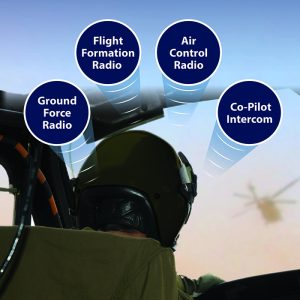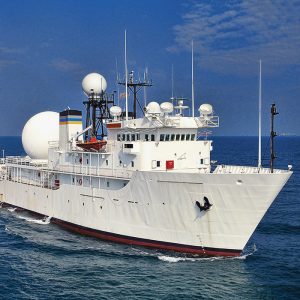In the information age, we have become accustomed to always-available communications. NGSO (non-geostationary orbit) satellites, once the exclusive domain of the defense market, has now become the order of the day in the commercial market as well. A steady stream of Low Earth Orbit (LEO) and Medium Earth Orbit (MEO) satellites has been launched into space over the past few years, allowing for innovative apps and services that enhance our quality of life and enable the study of the earth and the environment. The significant growth in the number of satellites has naturally increased the need for satellite ground stations and advanced tracking and communications systems that connect the earth-bound platforms to satellites, aircraft, UAVs, missiles and more.


Picture: Airborne 3D Audio Management
We met with Eitan Livneh, the President & CEO of Israel-based Orbit Communications Systems (TASE: ORBI), a leading provider of precision tracking-based communications solutions and airborne audio management systems, in order to better understand the innovations in the field of satellite communications.
“The increase in the demand for communications at any point on earth, at any time of day or night, led us to develop satellite communications solutions for remote ground stations and in-motion aircraft and ships. The challenges facing such systems include the ability to withstand extreme weather conditions, hop between satellite frequencies, maintain high broadcast quality and produce small-footprint terminals – all at competitive prices,” says Livneh.
Revolutionary maritime satcom
“10 years ago, it was very expensive to use a telephone or the Internet on a cargo ship or cruise liner. Thanks to satellite communications, today we can communicate freely in the middle of the ocean relatively cheaply. The most common solutions involve large on-deck satellite communications systems operating over one or two frequency bands,” Livneh explains.
For example, Orbit’s new OceanTRx 7 Multiband system features a 2.2m (7ft) antenna that transitions between C/Ka and Ku/Ka frequency ranges to enable fiber-like quality, cost-effective Internet services. It offers the same performance as a 2.4m (8ft) dish with a footprint of only 2.7m (9 feet). Orbit multiband terminal takes up to 40% less deck space than industry-standard 2.4m (8ft) systems and is more than 30% lighter than competitive solutions. Small enough to be shipped in a standard 20-foot container, OceanTRx 7 Multiband can be installed in half a day.
“OceanTRx 7, our flagship maritime satcom solution, is setting new standards in both the defense and civil markets. Leading navies use our solution for mission-critical communications. With it, cruise ships provide passengers with continuous Internet access while cargo ships monitor their goods in real time. We are proud to be at the forefront of this maritime satcom revolution as we provide our customers with a significant competitive edge,” Livneh adds.
Best-selling airborne satcom


Picture: Multiband Maritime Satcom
Orbit’s AirTRx family of innovative airborne stabilized VSAT systems provides high-quality broadband communications to multiple aircraft via satellite. Designed to accommodate the regional and global coverage needs of the airborne market, AirTRx supports Ku and Ka frequency bands. By providing outstanding RF performance and dynamic response under the most challenging conditions, it meets the broadband needs of mission aircraft, commercial and business jets, as well as helicopters.
“With more than 25 years of experience and over 1,600 operational systems worldwide, our customer base includes aircraft manufacturers and systems integrators, communications service providers, government agencies and armed forces,” reports Livneh.
Innovative airborne audio
“The audio management systems aboard an aircraft is a critical safety feature, whether we’re talking about commercial airliners, fighter jets or mission aircraft. Traditional audio systems make use of a star-topology architecture, in which a central communications unit is wired to the control panel of each of operator aboard the aircraft. While this method was suitable in its day, it does not meet today’s demands for unrestricted 3D Audio for each operator and system scalability,” continues the CEO.
In response, Orbit developed a Dual IP Ring topology delivering inherent system redundancy, reduced aircraft weight, incremental scalability and flexibility to suit any size civil or military platform. With 3D Audio, Adaptive Noise Reduction and Voice-Activated Detection provided as standard features, Orbit’s airborne audio management systems deliver a 360-degree clear audio experience with significant benefits for pilots, including increased situational awareness and flight safety, as well as reduced workload and fatigue.
In practical terms, pilots can now pinpoint the direction of the source of the sound, whether it be the voice of a crew person or air traffic controller, a threat warning on a military aircraft or a safety alert on a civil aircraft.
Customers for Orbit’s airborne audio management systems include the US armed forces, Airbus and Embraer as well as leading aircraft manufacturers in Israel and in the United States.
“Irkrut, the largest private aircraft manufacturer in Russia, selected the Orbit system for its newly released MC-21 single-aisle twinjet airliner, which aims to compete with Boeing 737 and Airbus A320. It has been successfully integrated into the aircraft and now constitutes one of its standard avionics systems,” indicated Livneh.
Industry-leading telemetry systems
Aeronautical test telemetry is used in defense and civilian applications, such as flight testing, space exploration and rocketry, to enable real-time monitoring of environmental conditions aboard aircraft, helicopters, missiles and UAVs in flight.
Orbit telemetry systems are used by military and civil space agencies to collect real-time measurement data in order to improve system performance. In-flight data transmission is particularly vital for missiles and UAVs because they are often damaged or destroyed before completing the test flight.
In the field of telemetry, Orbit combines:
- A broad installed base that includes major national defense organizations
- Fast target acquisition for unsurpassed tracking accuracy and quality
- Proven multiband (L/S/C/) solution for superior market performance
- Terminals capable of withstanding extreme weather conditions
“Notable among Orbit’s telemetry customers are NASA, Boeing, SpaceX, Lockheed Martin, Israel Aircraft Industries, Elbit, Rafael and various space agencies,” Livneh points out. “Such industry giants validate our leading position in this field.”
Down-to-earth LEO/MEO ground stations
“To address the explosive growth of non-geostationary satellites – fueled, in part, by the growing demand for Earth Observation (EO) applications – Orbit has developed the ultimate ground station. Our Gaia family is comprised of cost-effective, high-performance ground station systems capable of capturing data from LEO and MEO satellites,” comments Orbit’s CEO.
Orbit’s globally installed tracking systems operate under extreme environmental conditions to meet the needs of a broad range of challenging applications, including:
- Weather forecasting
- Disaster monitoring and control
- Search and rescue missions
- Surveillance for military and homeland security
- Oil and gas exploration
- Land mapping
- Telecommunications


Eitan Livneh
In conclusion
“In the dynamic world of satellite communications, with its ever-present demand for higher data rates at lower costs, there is a growing need for multiband satcom expertise. Known for our responsiveness to market needs and experience in delivering end-to-end communications solutions, we are dedicated to continuing to come up with innovative communications solutions that provide our customers with a competitive edge moving forward,” summarizes Livneh.







